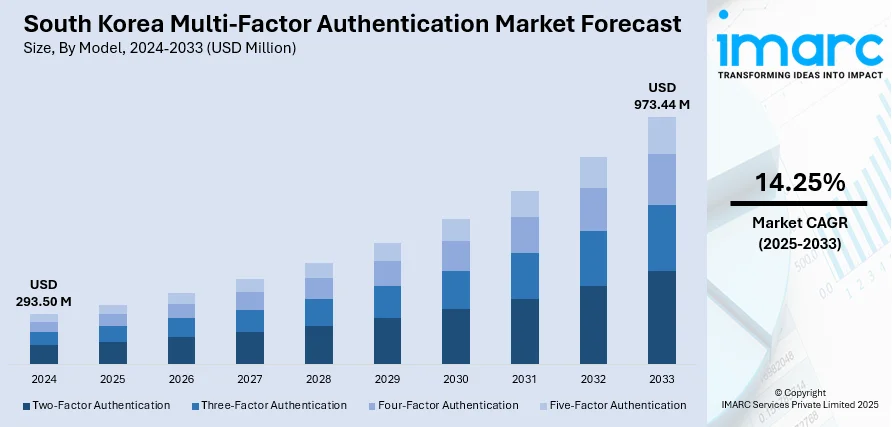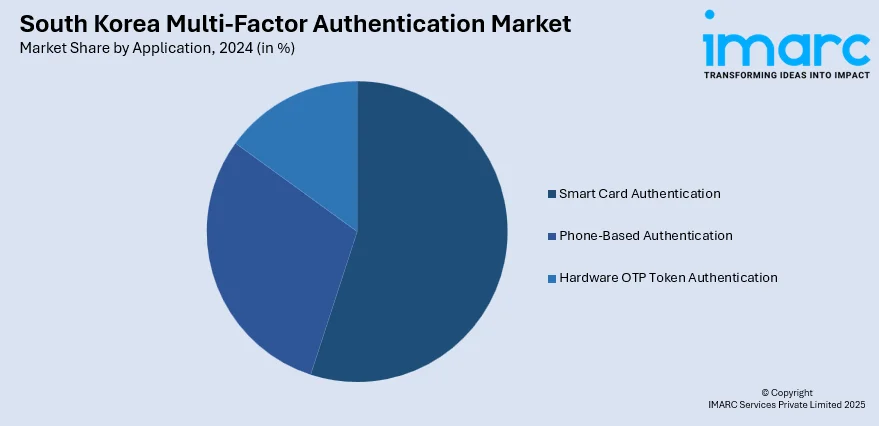
South Korea Multi-Factor Authentication Market Size, Share, Trends and Forecast by Model, Deployment Type, Application, Vertical, and Region, 2025-2033
South Korea Multi-Factor Authentication Market Overview:
The South Korea multi-factor authentication market size reached USD 293.50 Million in 2024. Looking forward, IMARC Group expects the market to reach USD 973.44 Million by 2033, exhibiting a growth rate (CAGR) of 14.25% during 2025-2033. The market is driven by escalating cybersecurity concerns, the increasing adoption of cloud-based services, and stringent government regulations mandating enhanced security measures. The rising prevalence of sophisticated cyberattacks further compels organizations to implement robust authentication solutions, thereby contributing to the expanding South Korea multi-factor authentication market share.
|
Report Attribute
|
Key Statistics
|
|---|---|
|
Base Year
|
2024
|
|
Forecast Years
|
2025-2033
|
|
Historical Years
|
2019-2024
|
| Market Size in 2024 | USD 293.50 Million |
| Market Forecast in 2033 | USD 973.44 Million |
| Market Growth Rate 2025-2033 | 14.25% |
South Korea Multi-Factor Authentication Market Trends:
Increasing Focus on Data Privacy and Security Regulations
The South Korean government and various private organizations are implementing increasingly stringent measures to protect sensitive information, driving the demand for MFA solutions. For instance, in May 2025, SK Telecom revealed that malware responsible for a massive data breach had gone undetected in its systems since 2022, compromising data of up to 23 million users. The company isolated 25 malware strains and quarantined 23 servers. In response, it launched a nationwide SIM replacement program and deployed FDS 2.0, a fraud detection system using triple-factor authentication. As a result, compliance with these evolving data privacy and security regulations is not merely optional but a legal imperative for businesses operating within the country. MFA serves as a fundamental component of these compliance efforts, significantly enhancing data security by requiring multiple authentication factors. This heightened regulatory scrutiny and the imperative to mitigate the financial and reputational risks associated with data breaches are compelling organizations across all sectors to adopt and invest in MFA technologies, thereby contributing to the South Korea multi-factor authentication market growth.

To get more information on this market, Request Sample
Technological Advancements and the Shift Towards Passwordless Authentication
The South Korea multi-factor authentication market is witnessing continuous technological advancements, with a notable trend towards passwordless authentication methods. Innovations in biometrics (e.g., fingerprint, facial recognition), mobile authentication services, and hardware security tokens are enhancing both the security and user experience of MFA. For instance, in March 2025, South Korea completed its nationwide rollout of a digital ID system, enabling all 52 million citizens to use mobile-based identification for public and private services. Known as i-PIN, the system is integrated with major banks, supporting account access, loans, and other financial services. This move follows earlier success with digital ID cards for foreign residents and reflects South Korea’s digital transformation strategy, emphasizing secure identity verification and high digital banking adoption, with 91% of customers already using digital services. Passwordless solutions aim to reduce reliance on traditional, vulnerable passwords while offering seamless and more convenient authentication processes. This continuous innovation, coupled with the increasing integration of MFA with cloud technologies and IoT environments, is expanding the applicability and effectiveness of MFA solutions, thereby fostering sustained South Korea multi-factor authentication market growth.
South Korea Multi-Factor Authentication Market Segmentation:
IMARC Group provides an analysis of the key trends in each segment of the market, along with forecasts at the country/regional level for 2025-2033. Our report has categorized the market based on model, deployment type, application, and vertical.
Model Insights:
- Two-Factor Authentication
- Three-Factor Authentication
- Four-Factor Authentication
- Five-Factor Authentication
The report has provided a detailed breakup and analysis of the market based on the model. This includes two-factor authentication, three-factor authentication, four-factor authentication, and five-factor authentication.
Deployment Type Insights:
- On-premises
- On-Cloud
A detailed breakup and analysis of the market based on the deployment type have also been provided in the report. This includes on-premises and on-cloud.
Application Insights:

- Smart Card Authentication
- Phone-Based Authentication
- Hardware OTP Token Authentication
The report has provided a detailed breakup and analysis of the market based on the application. This includes smart card authentication, phone-based authentication, and hardware OTP token authentication.
Vertical Insights:
- Banking and Finance
- Government
- Travel and Immigration
- Military and Defence
- IT and Telecom
- Healthcare
- Retail and E-commerce
- Others
The report has provided a detailed breakup and analysis of the market based on the vertical. This includes banking and finance, government, travel and immigration, military and defence, IT and telecom, healthcare, retail and e-commerce, and others.
Regional Insights:
- Seoul Capital Area
- Yeongnam (Southeastern Region)
- Honam (Southwestern Region)
- Hoseo (Central Region)
- Others
The report has also provided a comprehensive analysis of all the major regional markets, which include Seoul Capital Area, Yeongnam (Southeastern Region), Honam (Southwestern Region), Hoseo (Central Region), and others.
Competitive Landscape:
The market research report has also provided a comprehensive analysis of the competitive landscape. Competitive analysis such as market structure, key player positioning, top winning strategies, competitive dashboard, and company evaluation quadrant has been covered in the report. Also, detailed profiles of all major companies have been provided.
South Korea Multi-Factor Authentication Market News:
- In March 2024, Identiv Inc., which maintains a manufacturing and operational presence in South Korea, unveiled ScrambleFactor, a high-security physical access control system tailored for the federal market. This advanced reader combines fingerprint biometrics with an LCD touchscreen keypad, supporting multiple authentication methods to enhance security, speed, and user convenience. Designed to meet the stringent requirements of government agencies, ScrambleFactor also aligns with Identiv’s broader strategy to strengthen digital security across the Internet of Things (IoT) landscape globally.
South Korea Multi-Factor Authentication Market Report Coverage:
| Report Features | Details |
|---|---|
| Base Year of the Analysis | 2024 |
| Historical Period | 2019-2024 |
| Forecast Period | 2025-2033 |
| Units | Million USD |
| Scope of the Report |
Exploration of Historical Trends and Market Outlook, Industry Catalysts and Challenges, Segment-Wise Historical and Future Market Assessment:
|
| Models Covered | Two-Factor Authentication, Three-Factor Authentication, Four-Factor Authentication, Five-Factor Authentication |
| Deployment Types Covered | On-Premises, On-Cloud |
| Applications Covered | Smart Card Authentication, Phone-Based Authentication, Hardware OTP Token Authentication |
| Verticals Covered | Banking and Finance, Government, Travel and Immigration, Military and Defence, IT and Telecom, Healthcare, Retail and E-Commerce, Others |
| Regions Covered | Seoul Capital Area, Yeongnam (Southeastern Region), Honam (Southwestern Region), Hoseo (Central Region), Others |
| Customization Scope | 10% Free Customization |
| Post-Sale Analyst Support | 10-12 Weeks |
| Delivery Format | PDF and Excel through Email (We can also provide the editable version of the report in PPT/Word format on special request) |
Key Questions Answered in This Report:
- How has the South Korea multi-factor authentication market performed so far and how will it perform in the coming years?
- What is the breakup of the South Korea multi-factor authentication market on the basis of model?
- What is the breakup of the South Korea multi-factor authentication market on the deployment type?
- What is the breakup of the South Korea multi-factor authentication market on the basis of application?
- What is the breakup of the South Korea multi-factor authentication market on the basis of vertical?
- What is the breakup of the South Korea multi-factor authentication market on the basis of region?
- What are the various stages in the value chain of the South Korea multi-factor authentication market?
- What are the key driving factors and challenges in the South Korea multi-factor authentication market?
- What is the structure of the South Korea multi-factor authentication market and who are the key players?
- What is the degree of competition in the South Korea multi-factor authentication market?
Key Benefits for Stakeholders:
- IMARC’s industry report offers a comprehensive quantitative analysis of various Korea market segments, historical and current market trends, market forecasts, and dynamics of the South Korea multi-factor authentication market from 2019-2033.
- The research report provides the latest information on the market drivers, challenges, and opportunities in the South Korea multi-factor authentication market.
- Porter's five forces analysis assist stakeholders in assessing the impact of new entrants, competitive rivalry, supplier power, buyer power, and the threat of substitution. It helps stakeholders to analyze the level of competition within the South Korea multi-factor authentication industry and its attractiveness.
- Competitive landscape allows stakeholders to understand their competitive environment and provides an insight into the current positions of key players in the market.
Need more help?
- Speak to our experienced analysts for insights on the current market scenarios.
- Include additional segments and countries to customize the report as per your requirement.
- Gain an unparalleled competitive advantage in your domain by understanding how to utilize the report and positively impacting your operations and revenue.
- For further assistance, please connect with our analysts.
 Request Customization
Request Customization
 Speak to an Analyst
Speak to an Analyst
 Request Brochure
Request Brochure
 Inquire Before Buying
Inquire Before Buying




.webp)




.webp)












